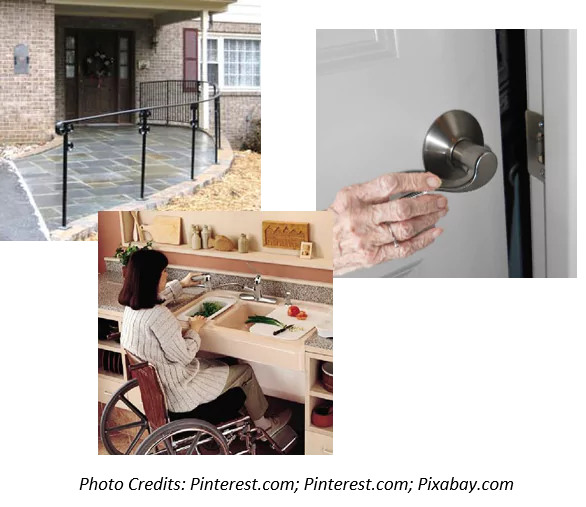
Cheyanne Blue, RLPS Interior Designer
Hi RLP Friends,
This month I thought I’d talk about Aging in Place. What exactly is that?
According to the CDC, Aging in Place means “the ability to live in one’s own home and community safely, independently and comfortably, regardless of age, income, or ability level.”
Do you find that your home doesn’t meet your needs now that you’re older? As you look around your home can you spot things that could be modified to better suit your physical requirements? Here are some tips according to an article on Architectural Digest.com by Alexandra Kalita.
Throughout the Home
Opt for mechanisms that are easier to operate when mobility is impaired. For example, choose door levers over doorknobs. Light switches with a rocker panel are preferable to a toggle switch. Awning-type window units are the easiest to open and close.
Consider how technology-powered devices can facilitate aging in place. Mechanisms like front door locks, lighting, or thermostats that you can control with a smartphone can be easier to operate in advanced age. Though when exploring these options, consider maintenance requirements, the risks associated with malfunctions, and whether they can be operated on a device with a larger screen, like a tablet. Icons can be difficult for the visually impaired to navigate on a smartphone screen.
Wainscoting, chair rails, or shelves that protrude from the wall can aid balance, as long as they are thick enough to grip and securely attached to the wall.
To reduce glare and shadows, which create trip hazards for seniors with faultier depth perception, install indirect lighting. To reduce how often you’ll need to change light bulbs, install LED fixtures. The Aging in Place guide recommends a color temperature between 2,700 and 3,000, as well as a color rendering index of 100. Two-way switches are recommended. They are particularly useful in bedrooms, so you can turn the light on upon entering through the doorway, and turn it off from the bedside.
Install electrical outlets at 18-to-24 inches off the ground, to reduce how far you’ll have to bend down to access them.
If you live in a multi-level home, locate the master bedroom on the ground level, and include a bathroom on each floor.
Flooring
Opt for soft and smooth surfaces, like cork, rubber, and linoleum. These softer surfaces will be kinder to joints but won’t pose a trip hazard, like high-pile or excessively padded carpets can.
Keep flooring smooth and level, to the extent you can. Where level changes are unavoidable, signal them with a change in material, texture, or color, but avoid strong patterns or shiny surfaces that may interfere with depth perception.
“Just be a little bit conscious of how level changes will impact someone with impaired vision who is more susceptible to tripping,” Wright suggests. “If you have a threshold in your house, you know what’s a really quick and cheap fix? Grab a can of paint and paint it in a different color.”
In the Kitchen
Include a surface where you can sit to prepare meals. Standing for long periods of time may become more onerous as you age.
Consider an island on wheels, so that the position could be adjusted to provide clearance for a walker or wheelchair.
Don’t install cabinets over the stove. Leaning over a hot surface can pose a hazard, particularly when balance is impaired.
Opt for drawers under your countertop, in place of lower cabinets.
D-type pulls are the easiest to grip when opening and closing cabinets.
In the Bathroom
An adjustable-height showerhead with a handheld wand can extend your ability to bathe independently, an activity that can have a demonstrable impact on preserving emotional wellbeing and sense of dignity.
If you’re building a new shower, choose a no-threshold or walk-in shower and consider incorporating a seat into the design. If you’re renovating an existing shower, base-row wall tiles that contrast with the floor tiles can help you distinguish between wall and floor more readily.
If you have a bathtub and shower combo, a shower curtain is preferable to sliding shower doors. Shower door tracks should not be installed on the bathtub rim.
Standard towel bars are not designed to support body weight, but many manufacturers do offer grab bars specifically designed to replicate the appearance of a towel bar and aid mobility.
Thermostatic shower controls and anti-scald water devices can help protect against injury. The Aging in Place guide recommends a maximum water temperature of 120 degrees.
(Source: Article by Alexandra Kalita for AD [Architectural Digest] October 23, 2017. Accessed February 17, 2023.)
Remember, here at Renewed Life Properties, we can help your home fit your needs no matter your age. Don’t sell, renovate!


